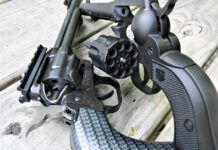The quest for value is never ending in the hunting rifle market. Hunters traverse fields and mountains in search of deer, elk, moose, and other game, and they likewise amble through aisles of gun stores searching for the best game-getter for the lowest dollar possible. However, they may be overlooking the best deals by not considering used firearms available at gun shows, in online auctions, at pawn shops, and, yes, at those selfsame gun stores. But what is a good deal? Definitions vary. But most of us would agree that finding a secondhand, good-shooting gun for a couple of hundred dollars is a treat, so knowing what to look for is important.
We recently stumbled across a Weatherby Vanguard Series 1 308 Winchester for only $300, and online searches showed many more of this older model are available for that plus another $50 to $75. At the same time, we also came into possession of a Ruger American Rifle No. 6903, also in 308, which has an MSRP of $449 but can sell at $50 to $75 off that, making the pricing of an individual gun pretty close between the two. Both rifles are hunting models fitted with synthetic stocks, blued barrels, sling studs front and rear, and rubber buttpads. We wanted to know which is the better buy – a used gun thats basically selling half-off its original price, or a brand-new gun that comes with the confidence that only the buyer has shot it? We endeavored to find out in a head-to-head match-up.
We tested an American chambered in 243 Winchester in the February 2013 issue, and we said then that the pricing might make it a popular choice for deer stands. Also, it had a well-made stock with integral bedding blocks, a precise single-stage trigger, and was a generally well-thought-out, smoothly assembled rifle. Five years ago we tested a then-new Weatherby Vanguard Series 1 Stainless in 270 Winchester and found that gun lived up to its guarantee of three-shot groups of 1.5 inches or better fired from a cold barrel with premium ammunition.
To get things going this time, we mounted a 30mm Leupold VX-R 3-9x40mm Matte FireDot Duplex scope (Leupold #110686, $456.24) on the Weatherby using Leupold 30mm medium-height rings (Leupold #49957, $35.30) and Leupold Dual Dovetail Weatherby Mark V 2-piece bases (Leupold #51706, $17.78.) The FireDot scope has an illuminated dot right in the center of the duplex reticle. Its intensity can be stepped down by a switch on the left side of the scope – a useful setup for low-light conditions. For the Rugers optic, we selected a Sightmark 3-9×42 Triple Duty Riflescope SM13016. Made in China, the Triple Duty is equipped with an illuminated red/green Mil-Dot reticle, which aids in range estimation and shooting in low light conditions. We liked the bright and crisp picture the fully multi-coated optics transmitted. The 3-9×42 features a one-piece 30mm tube that is O-ring sealed and nitrogen purged, making it fog proof and water resistant. This scope features oversized, locking windage and elevation turrets with -inch-MOA clicks. It came with a set of 30mm rings, but we used some Weaver Tactical Rings (No. 48351) mounted to Weaver bases to put the Sightmark on and rotated it 90 degrees counterclockwise so we could reach the illumination dial more easily with the left hand.
To determine the accuracy of standard hunting ammunition, we selected the following test rounds: Federal Premium 308 Winchester 168-grain Matchking BTHP GM308M; Winchester Super-X 308 Winchester 150-grain Power Point X3085; and Freedom Munitions 308 Winchester 150-grain FMJ. As the accompanying accuracy table shows, the Vanguard shot within its 1.5-inch guarantee with two rounds, the Freedom Munitions FMJs and Federal Premium Matchking boattails, with the Ruger trailing in accuracy performance across the board. As we wrung them out, we noticed other pros and cons with both rifles, which we report below:
Weatherby Vanguard S1308 Win., $300 (Used)
The Vanguard dates back to 1970 when Weatherby contracted with Howa in Japan to produce a more affordable rifle line. The Vanguards got a bad rap from some shooters because the line didnt include Weatherby cartridges until 1988. But the rifles had long had a reputation for accuracy, and in fact were marketed with 1.5-MOA accuracy guarantees. Some of the Vanguards shot better than that and were marketed with 1-MOA accuracy guarantees. Vanguards have been offered over the years in at least 17 different models, and the Series 1 line has been replaced by the Vanguard Series 2 rifles, which are guaranteed to shoot a three-shot group of 0.99 inch or less at 100 yards when used with specified Weatherby factory or premium ammunition. Other upgrades the V2s have are match quality two-stage triggers adjustable down to 2.5 pounds, composite Monte Carlo Griptonite stocks with pistol grip and forend inserts, and a right-side palm swell. The V2s also present matte bead-blasted finishes and three-position safeties. They start at about $700. At one point, Weatherby lowered the price on the synthetic/blued S1 Vanguard to only $399, and we bought our used sample for $99 less than that. If you shop smart, you can have one of these rifles for a very affordable price.
The 24-inch barrel measured .620 inch at the muzzle and had a six-groove, 1:10 RH twist. The Vanguard barreled action is made by Howa Machinery Co. Ltd. of Nagoya, Japan, and was set into the synthetic stock with two slot-head screws. Examination showed no bedding block, and the barrel didnt free float. The barrel and receiver were matte blued-black steel. The trigger pull was very good and can be adjusted to make it better still. There was no discernible take up, and overtravel was nonexistent. Ours broke consistently at 3.5 pounds, and we left it that way. However, a Timney trigger is something we would consider adding.
The Vanguard is a full-sized rifle that balanced directly under the chamber mouth. The gun by itself weighed 7.25 pounds, but its field weight with scope and full complement of 308 rounds was 9.3 pounds. We found the Vanguards green synthetic stock to be very comfortable, with molded-in checkering on the pistol grip and forearm. Our shooters said the Monte Carlo comb offered a good head position on the stock, and under recoil, as the comb was pushed rearward, the stock dropped away from the face, reducing recoil transmitted to the cheekbone. Sling swivel studs come factory installed in the butt and forearm. A 1-inch-thick soft-rubber buttpad made shooting the rifle pleasant as well.
The Vanguard has a 90-degree bolt lift, in contrast to the Mark Vs 54-degree movement. The bolt has two forward, opposing locking lugs. The claw extractor is spring-loaded and 0.25 inch wide. The ejector is a spring-loaded plunger in the enclosed bolt face. The bolt body has longitudinal flutes that reduce friction during bolt travel, has three gas ejection ports in case of a cartridge case failure, and has a fully enclosed bolt sleeve. The bolt stroke with all brands of ammunition was smooth and effective, our shooters said. Empties ejected about 3 feet away and slightly behind the action. The bolt-release button is on the left rear side of the action, and the shooter doesnt need to pull the trigger to slide the bolt out. The ejection opening is large on the Weatherby, so it is easy to single load cartridges at the range. We had to load the Ruger using the magazine.
The floorplate release is located on the outside of the trigger guard. The drop-plate design allows quick unloading without cycling the cartridges through the action. The safety is a two-position toggle on the right of the bolt shroud, and operates crisply with positive, distinct clicks to the rear (Safe) and to the front (Fire). Safe also locks the action.
Our Team Said: Vanguards were guaranteed to shoot a 1.5-MOA group with at least one load, and we got that performance with two different bullet weights. Overall, the Weatherby is a heavy-duty rifle that feels solid and weighs more than the Ruger. For most hunting, wed pick it instead of the American.
Ruger American Rifle No. 6903308 Winchester, $449
The Ruger American rifle is currently chambered in 243 Winchester, 270 Winchester, 30-06 Springfield, and 308 Winchester. Empty and without optics, our rifle weighed 6.25 pounds. Loaded with the Sightmark scope and five rounds, its fighting weight was 8.25 pounds. The 308 fires through a 1:10-inch-twist hammer-forged barrel, the same twist rate as the Vanguard.
Getting to the bad news first, we thought the Rugers accuracy results were disappointing. With the Freedom Munitions 150-grain FMJs, the American shot 3-inch groups compared to 1.4-inch groups with the Vanguard. The Ruger did appreciably better with the Winchester Super-X 150-grain Power Points, notching 2.4-inch groups compared to 1.8-inch groups for the Weatherby. The Ruger shot the same size groups with Federal Premium 168-grain Matchking boattails, but the Weatherby improved somewhat to 1.4-inch groups.
Rugers Marksman adjustable trigger has a hinged tab called a trigger release seated inside the trigger face. To move the trigger rearward, this skeletonized tab must be compressed against the trigger face. The Allen-type trigger-weight adjustment screw was located at the front of the trigger housing. It takes about three turns to change weight of pull 1 pound, and pull weight can vary from about 3 pounds to 5 pounds of resistance. We left it at the weight it was received, about 3.8 pounds. We found pressing the release tab to be distracting, but the trigger break was reasonably crisp.
Our testers noted how narrow and light the stock felt, and lefties praised the buttstock for feeling neutral, even if they had to reach over to work the bolt. A plus: Ruger ships each rifle with a card redeemable for a free cheek pad that adds height and softness to the stock as well as a side pocket and cartridge loops. The buttstock felt fine as it was, but we might like to have one of those cheekpads just to have a set of cartridges handy.
The flush-fit four-round rotary magazine was compact, and the release latch was located on the magazine itself. At first we had trouble loading the magazine because, after the first round was in place, it took a little twisting to press down and slide the rounds into place front to rear. Once in the gun, the loaded magazine fed rounds smoothly and without incident, but we kept trying to open the bolt and load a single round into the top of the magazine, which didnt work too well. The three-lug stainless bolt has a 70-degree throw, requiring less rotation than the Vanguard.
Inside the stock is Rugers ingenious Power Bedding system, two V-shaped blocks of cast stainless steel that function in some way like a bedding block. Loosening two 3⁄16-inch Allen bolts on either side of the magazine well released the barreled action from the stock. In the receiver in front and behind the ejection port are matching sets of slots that merge with V-block fingers. To secure the action to the stock, the shooter snugs down two Allen head screws, creating a metal-to-metal fit between the barreled action and the stock.
An important point when reseating the action into the stock is to remember that the two Allen bolts can be overtightened. Maximum pressure is about 75 inch-pounds. According to Ruger, it was probably safe to use a small hand wrench, thanks to the limited amount of leverage such a tool provides.
Our Team Said: This version of the Ruger American didnt shoot nearly as well as the 243 Win. tested in February. We think some of the inaccuracy was due to barrel heating because we shot one half-inch cold-barrel group that was simply remarkable. Thereafter, the American shot passably well, but not superbly. Head to head with the Vanguard, wed only pick the Ruger if we wanted to cut weight.
Written and photographed by Gun Tests Staff, using evaluations from Gun Tests team testers. GT




























